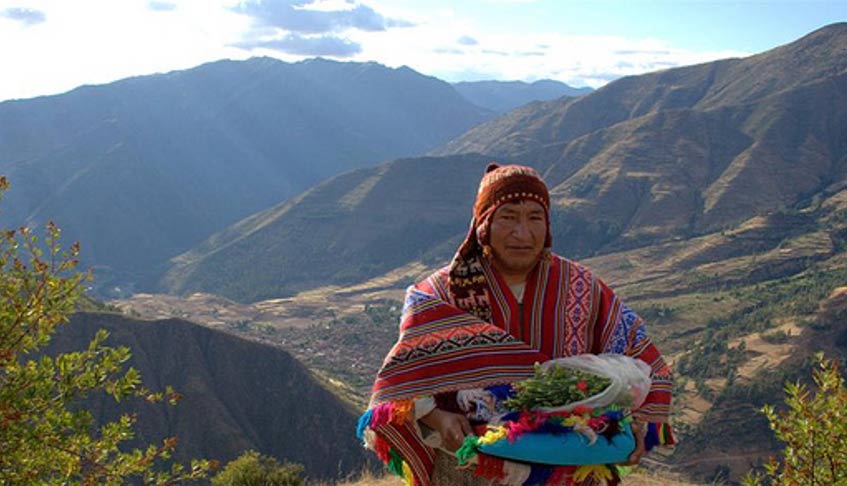
The Traditional Offering Ceremony of the Andes: How to Maintain Balance Between the Material and Spiritual Worlds
In traditional Andean cosmovision, the natural world and the divine are united, and offering ceremonies are seen as a part of the reciprocity system between the material and spiritual worlds. Haywarikuy (offering gifts in a sacred manner), ayni (reciprocity), ofrenda (offering), and despacho (message) all are words used for the sacred offering ceremonies of the Quechua, Quichua, Aymara and other indigenous peoples in the Andes region. Although several types of these ceremonies take place all over Latin America (and by other names around the world), the focus here will be how this ritual presents itself in the Andes region. Nonetheless, the popular practice of the same name that takes place on the Day of the Dead (Dia de los Muertos) in Mesoamerica will be examined as well.
Purposes of Offering Ceremonies
Due to the very nature of the ceremonies, material evidence of the sacred offering rituals in the Andes tends to be scarce, however, scholars have dated these types of ceremonies back to the time of the Inca (1100-1535 AD). Since then, offering ceremonies have been passed down through the generations.
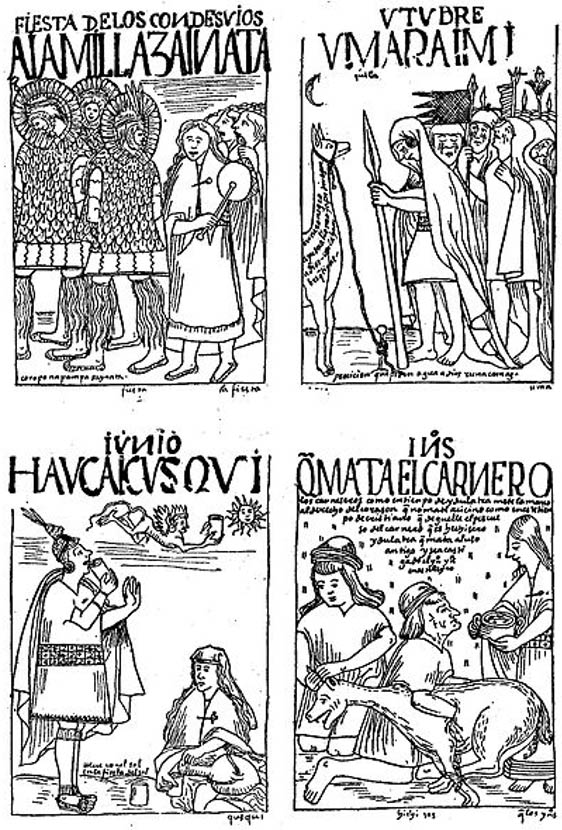
Four Incan ceremonies as depicted by Felipe Guaman Poma de Ayala. (1615) (CC BY SA 3.0)
The importance of the ceremony is seen as vital to life in the Andes. As written by a practitioner for the project Sapan Inka:
“The offering ceremony is an act of cosmic reciprocity, it is the realization of universal and cosmic justice, the completion of a mutual task. Breaking this principal would cause serious distortions in the balance of the natural, social, and religious systems. For the Andean person, offerings are a way to show reconciliation with spiritual forces and have the intention to avoid offences against these forces, they also represent rites of passage.”
Over 200 types of these traditional ceremonies exist and the practice differs from one location and purpose to another. As evident in the Quechua word “ayni,” offering ceremonies are meant as a form of reciprocity between the material and spiritual worlds. The traditional ceremonies focus on this exchange, as well as worship and thanksgiving, to the beings to which they are presented. According to Loreto Quiroz, a practitioner of traditional offering ceremonies, the rituals also serve as acts of love for their participants, reminding them of their connections to “all beings, elements, spirits, and sacred spaces.”
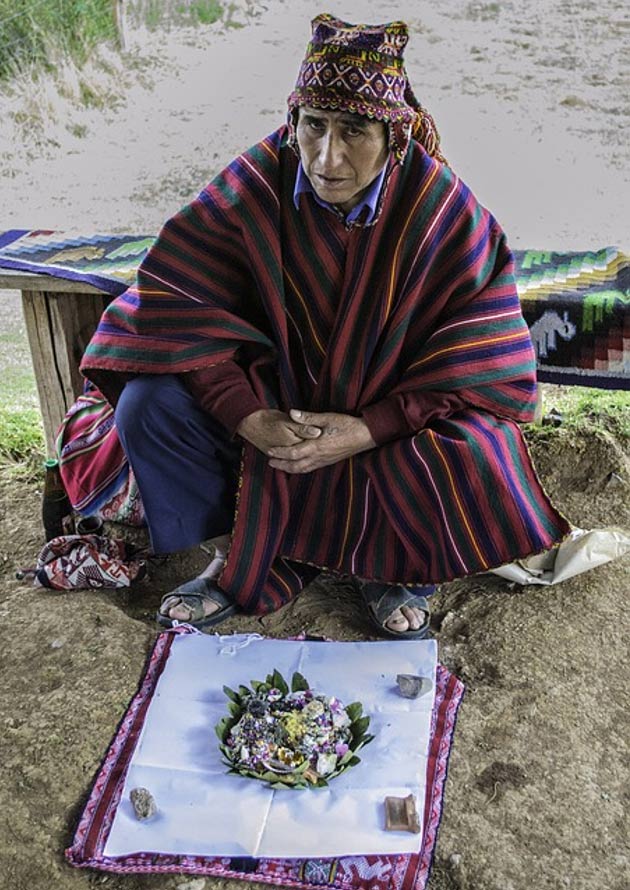
An Andean spiritual leader during an offering ceremony. (Public Domain)
The Q’ero (a Quechua speaking group in Peru) elder, Don Manuel Quispe (also spelled Q’espi) once said that:
"The despacho is a gift- a giving back of what we receive every day in our lives. We seek, through the despacho ceremony, to bridge the ordinary and non-ordinary realms; to establish new patterns of relationship and possibility. The despacho places us in right relationship, right ayni, with the Pachamama. It establishes a linkage between our three centers of interaction in the kaypacha (the physical universe); our llankay (our personal power and source of action, located in our solar plexus), our munay (the source of our love, located in our heart chakra), and our yachay (wisdom, sourced from our foreheads or "third eye").
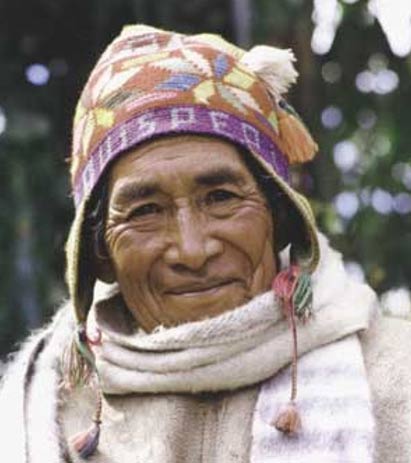
Don Manuel Quispe (1905-2004) was a Q’ero elder and spiritual leader who many called “The Last Inka.” (Jon Rasmussen)
Many entities are thought to receive the gifts offered in the sacred ceremonies, some of these are: the mother earth (Pachamama), mountains (Apu), and other spirits of nature such as animals, rocks, and trees. The sun (Inti) and moon (Killa) as well as the stars (Chaska), can also be subjects that are given the gifts of the ceremony. Don Manuel Quispe provided insight into the purpose of five of the Q’ero despacho ceremonies. This is what he has said about each:
"The Pachamama despacho is an offering of thanks to Mother Earth and an invocation for her blessings.
The Apu despacho is an offering to the mountain, which is the provider of the waters. When the mountain glaciers melt they provide the water that feeds the high mountain streams and lagoons. The mountain is the bringer of the weather as well.
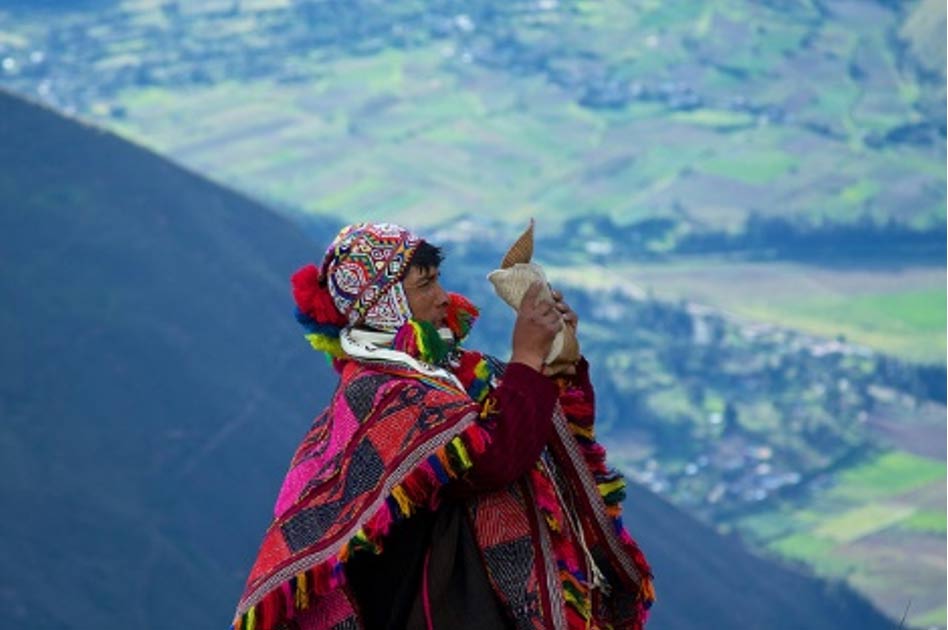
A Q’ero Paqo asks the Apu spirits to bless a mesa in an offering ceremony in Peru. (CC BY 2.0)
The Chaska despacho is an offering to our star, the sun. This despacho is not prepared as often as the offerings to the Pachamama and to the apu. Most of our business has to do with living in this world. Only when very big events (such as an earthquake) are occurring, or whenever an offering is made for the benefit of a great number of people, are Chaska despachos prepared. In this case, the stars as well as Mother Earth and the apu must offer their contribution.
The Aya despacho is performed to aid the luminous body of the dead or dying to step outside of the physical body gracefully. It is said that the spirit of the dead lingers in the vicinity of the physical body for seven days. The medicine person knows when it is necessary to help the luminous body to sever its connection with the physical.
The Cuti despacho: Cuti literally means 'turning back' or 'shielding off.' It is an offering for protection. This despacho is typically created with the left hand only, and all motions of placing items in the despacho are performed in a counter-clockwise (or unwinding) fashion. The right arm is in 'dreamtime' while the left arm performs the action.”
Offerings to the Pachamama are especially common, as many of the indigenous Andean people continue to work in agriculture, thus their relationship with the earth is strong. Offering ceremonies to the Pachamama are common practice in many locations at the beginning of the agricultural season. Pachamama is believed to be exhausted from the last harvest, thus the goal of the ritual is both to thank the land for the crops given in the last harvest, as well as to strengthen the earth for the upcoming sowing.
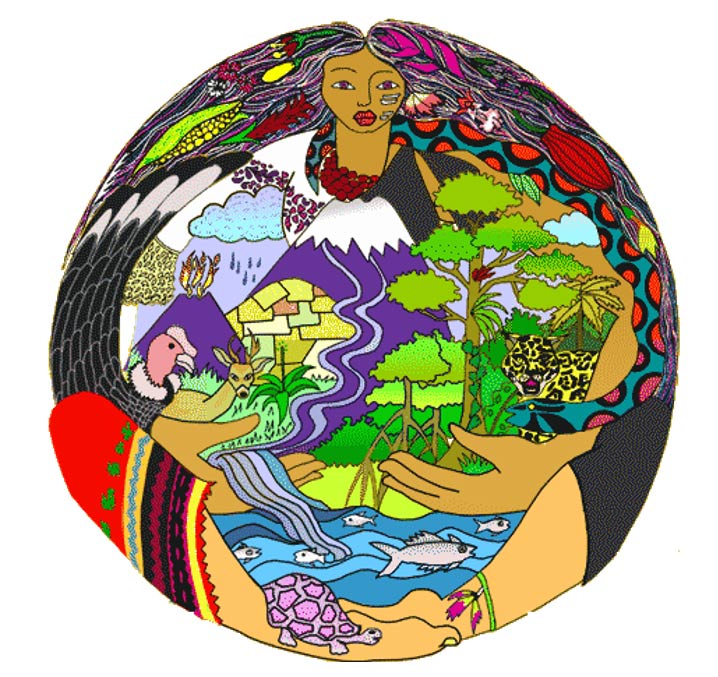
A representation of the Pachamama (mother earth). (Takiruna)
Beginning Traditional Offering Ceremonies
With so many reasons for offering ceremonies, it is not surprising that they can be witnessed year-round in the Andes region. There are common overall aspects to the practice, although the particular process and some of the items in the ceremony will obviously change based on the particular type of healing that is sought.
Some of the more elaborate ceremonies can take up two days, with the first day as preparation for the second, in which the actual event will take place. The first day of the ceremony involves inviting and informing the participants on what they must wear and bring to the event, placing all the necessary materials near the location in which the ritual will happen, and the lighting of a sahumerio (aromatic smoke) to inform the spirits of the ritual that will take place and to “clean” the energy of the space.
The time to begin the ceremony depends both on the purpose and the beliefs of the practitioners. Many argue that the best time to start an offering ceremony is at sunset, when the pachachaka energética (spiritual bridge) is most accessible and the spirits are more present. Nonetheless, other leaders of offering ceremonies prefer dawn, noon, or midnight.
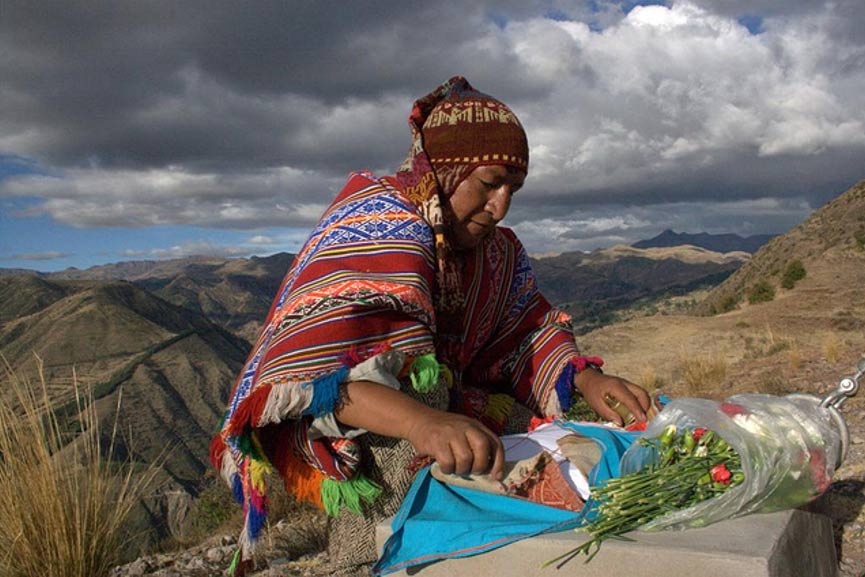
Preparations for an offering ceremony in Peru. (CC BY NC SA 2.0)
Regardless of the hour that is chosen, all would agree that punctuality is important for the ceremony. After greetings are made, the participants in a traditional ceremony will tie a colored string (or black or white alpaca yarn) around their ankle, wrist, and/or neck. The purpose of the string is to appease the Pachamama. Once the ceremony begins and the “sacred circle” is closed, the participants are committed to their attendance and no others are allowed to enter. A person must completely dedicate all of their attention and energy to the ceremony, which may take up to four hours.
The traditional leader of the offering ceremony is a “medicine person” or spiritual leader (either male or female) who has spiritual power – this person is sometimes called a Paqo, Altomisayoc, Yatiri, Curandero, or Shaman, depending on the culture that holds the ceremony. These spiritual leaders have to go through a series of long and complex tests to be entrusted with guiding an offering ceremony.
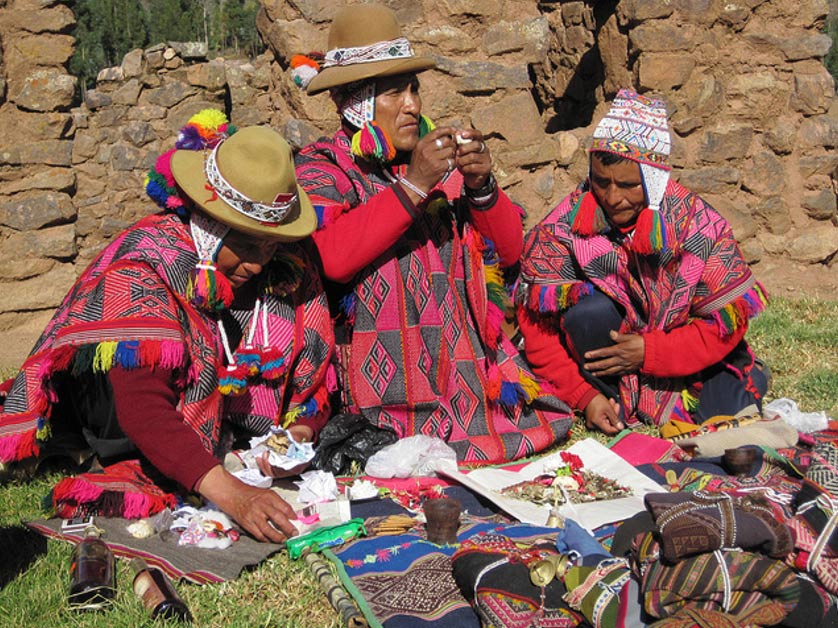
Q’ero spiritual leaders preparing items for offering ceremonies in Pisac, Peru. (CC BY 2.0)
Arnaldo Quispe has described the hole or mesa (table) as a key feature to the offering ceremony as “it performs the role of an altar, waca (sacred place), a paqarina (symbolic womb in the earth), and a pachachaka (bridge to contact the spirits) all at once.”
In traditional ceremonies, the hole should ideally be made in the shape of a circle with a diameter of one meter (3.3 feet) and a depth of 1.5 meters (4.9 feet). The best location for this hole is said to be an open area (but not too far from a tree or mountain). However, the intention of the ceremony is the most important and modern offering ceremonies may differ from these specifics.
Activating the Elements
In the ceremony, certain elements must be “activated”: fire, air, water, and earth. To activate the fire element, two fires are normally lit, a small one within the hole (made up of wood, palo santo (a tree related to frankincense, myrrh and copal), tobacco, laurel leaves, rosemary, and eucalyptus), and a larger one nearby – in which participants are encouraged to place their notes to the spirits, in which they can ask for help or forgiveness for their mistakes and defects.
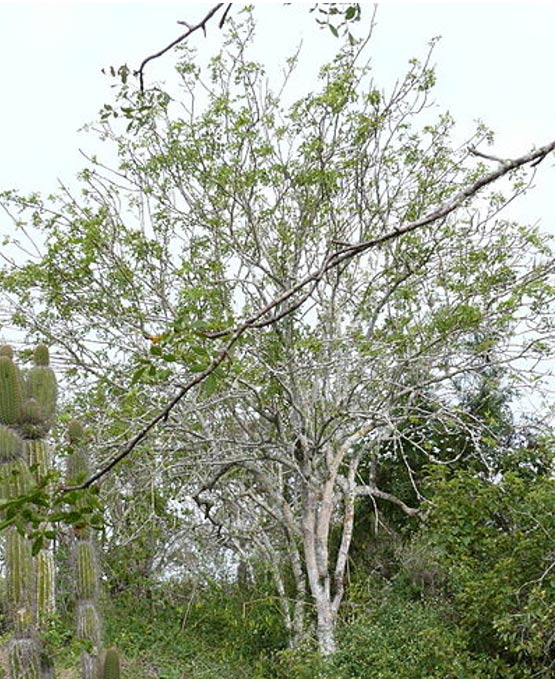
A Palo Santo tree (Bursera graveolens). (CC BY SA 3.0)
To activate the air element, incense is lit (which is said to please the earth and remind it of its abilities). Then some participants will smoke an unfiltered cigarette and provide the earth an opportunity to “smoke” the cigarette as well. Ashes from this cigarette are kept to paint the faces and to see if the earth is happy with the ceremony (if so, the ashes will supposedly be whiter).
The water element is activated by toasting the earth with chicha (a fermented corn liquor), beer or, aguardiente (a local spirit or liquor). In the ritual, the Pachamama “drinks” first, and then each individual will drink after toasting the earth.
The earth element is activated when the participants feed to each other coca leaves (after blowing their wishes onto them) and the chaqchar (chewing without swallowing) of coca leaves begins. The earth element continues to be activated with the offerings themselves.
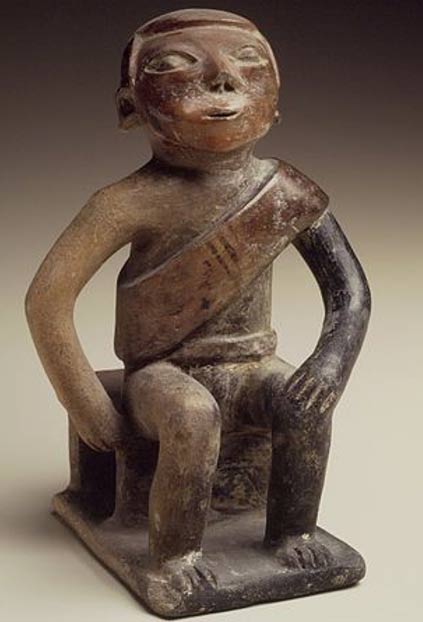
A coquero (figure chewing coca) dated to 850-1500 AD. (Brooklyn Museum)
Making the Offerings and Closing the Ceremony
Each member of the ceremony approaches the hole, kneels, and makes a prayer, request, thought, song (if permitted - some ceremonies insistent on total silence), or meditation to the spirit(s) receiving the gifts, and then places their material with both hands into the hole.
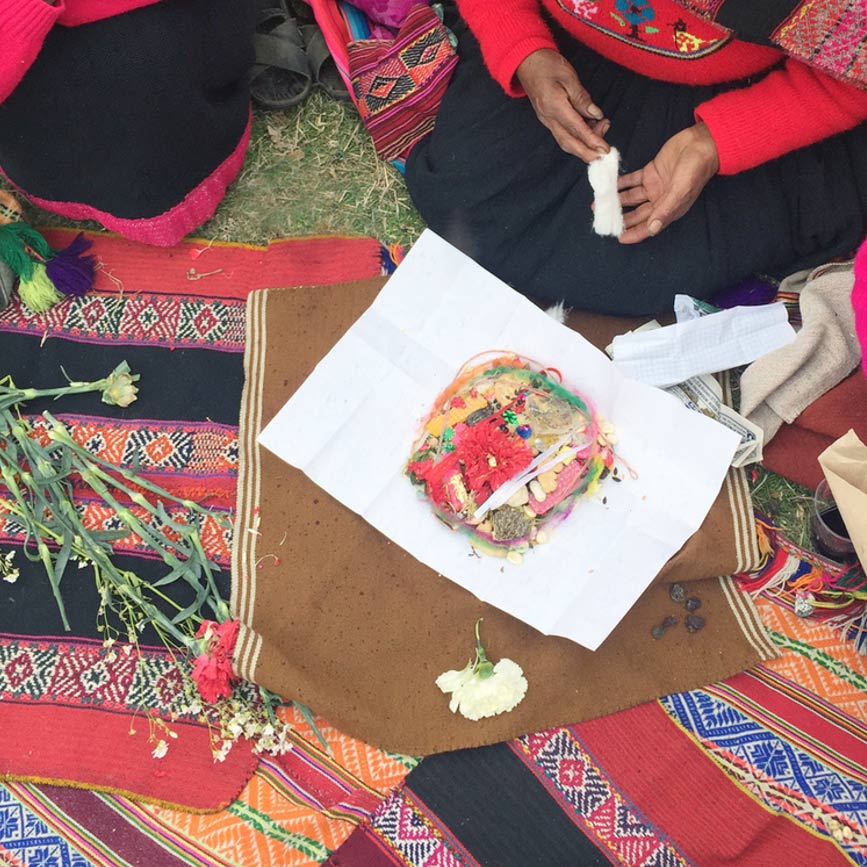
Making offerings. (Puakai Healing)
The order for the materials is: first coca leaves (or laurel or bay leaves, in places where coca is not permitted) are placed in the hole as the holders of the prayers and wishes, then foods and sweets (which sustain humans and nature and provide love and sweetness), and finally the rest of the items are laid within. Some offering ceremonies also include llama, pig, or sheep fetus – called sullus, continuing the Inca tradition of llama sacrifice to their gods. All of the items used are symbols for different parts of the Andean cosmology, create a balance of the masculine and feminine aspects of life, and are placed in the form of an elaborate mandala.
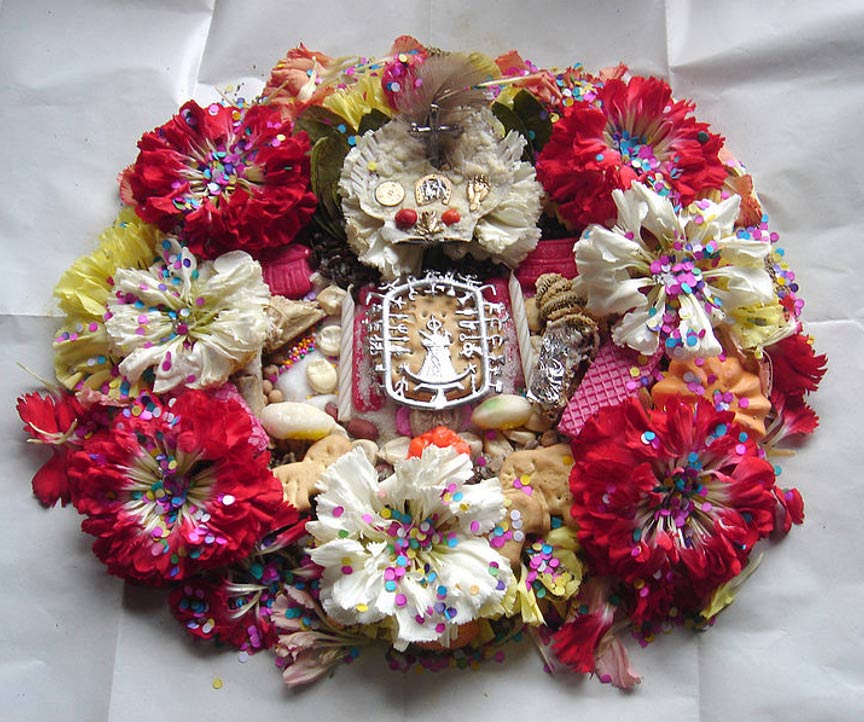
A beautiful mesa with flowers, sweets, leaves, grains, and other symbolic materials. (CC BY SA 2.0)
Regarding the symbolic nature of the items, Quispe said: “Though the contents may have symbolic significance, the despacho, when performed with the correct intent, transcends literal and symbolic domains and directly accesses the archetypal and energetic realms.”
During the ceremony, followers of the practice believe that it is also important to pay attention to any of the spirits’ signals - and the fires, ashes, any sounds or movements, can all have a meaning.
Upon completion of the offerings, all participants toast the ceremony, wrap the offerings in a mestana (traditional Andean woven fabric), and then dispose of in one of three ways: burning, burying, or throwing the offering into deep water. The burning of the offering is meant to ensure that the wishes/prayers reach the spirits of the upper world. However, if the mesa is burned than no one is allowed to see the fire until the offering is completely gone (symbolizing the liberation from the desire to have the objects within). If the offering is buried, rocks and a scattering of flower petals are placed on top and the objects are returned to the mother earth, from where they are said to have come from. Finally, if the offering is placed in deep water, it could also be a symbolical means to liberate the individuals from the desire for the possessions within.
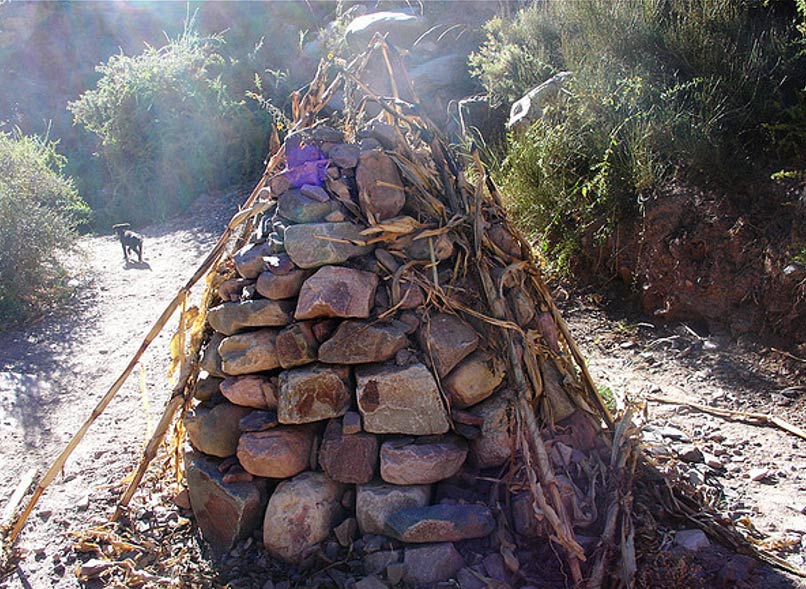
The completion of a large offering to the Pachamama. (CC BY SA 2.0)
Modern Adaptations to Traditional Offering Ceremonies
Offering ceremonies have also been adapted to the urban lifestyle in many sectors of the Andes, as apart from practicing the rituals to the natural entities for a good agricultural season, these beings are also frequently asked today for help in the form of protection, work, health, prosperity, or love.
The three vital elements to an offering ceremony are the spiritual leader, the items to be placed in the offering, and the participants. However, the rest may vary, and in modern times, the urban believers may also lead the ceremonies themselves with their necessary “ingredients” (called alcanzo or simply mesa) found in specialty shops, or in more popular times for the ceremonies, the items can even be located in most local markets. It is also possible for people living outside of the Andean region to order these kits (which are said to be created by shamans) online.
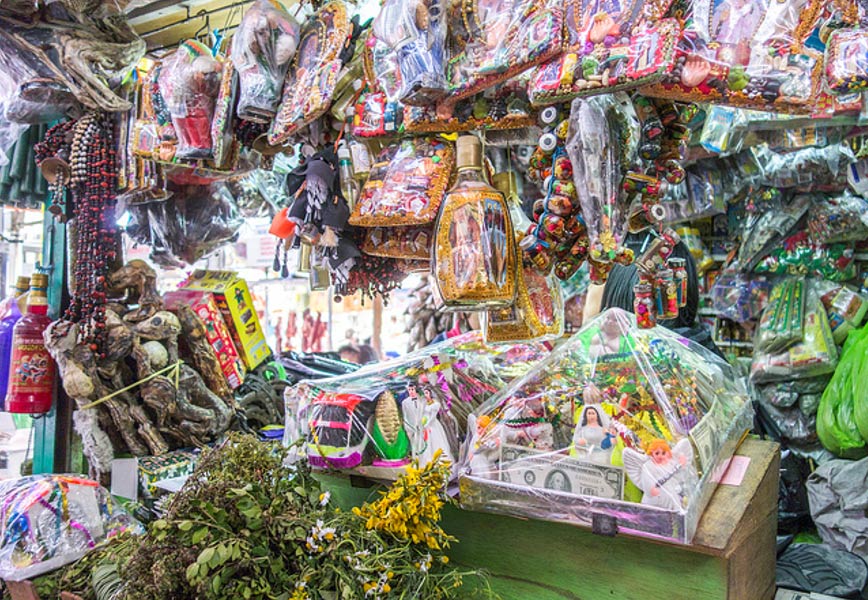
Various supplies and pre-made mesas for offering ceremonies on sale in Arequipa, Peru. (CC BY NC ND 2.0)
The Offering Ceremony of the Day of the Dead
Another type of offering ceremony in Latin America is the popular ceremony that takes place on the Day of the Dead (Día de los Muertos/Difuntos) – November 2. In the Day of the Dead ofrenda, the items chosen are special gifts to the dead, photographs, religious items, numerous candles, and food and drinks. Usually the ritual takes place at a shrine to the deceased loved one in a family member’s home. The offerings in the ceremony also contain symbolical objects that represent the four natural elements of earth, air, fire, and water.
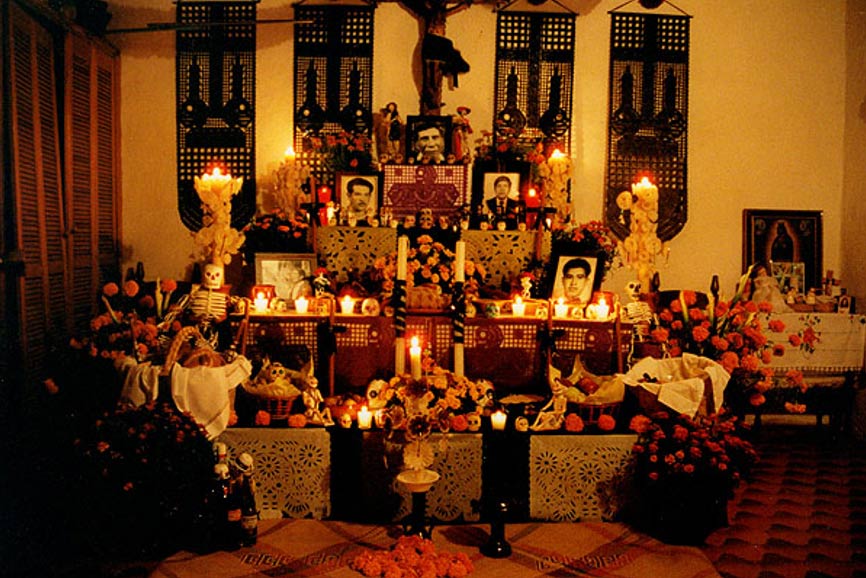
An ofrenda shrine for Día de los Muertos in Tepoztlán, Morelos, Mexico. (CC BY 2.0)
The offering ceremonies on this day are often more lighthearted and festive than the traditional ceremonies of the Andes. Music, dancing, and a feast are all common components added to the other rituals. According to Zarate, the Day of the Dead rituals are meant to be a way to “commemorate the lives of the dearly departed and welcome the return of their spirits.”
However, that is not to say that they are just parties, and the Day of the Dead activities are well-planned and can take weeks to enact. Some of the deeds that are necessary leading up to a traditional Day of the Dead celebration are to: visit the cemetery and clean the grave, have a picnic “with” the deceased, place flowers (specifically Cempasuchitl – a type of marigold), candles, and incense at the grave, and then scatter petals from the grave to the family’s home.
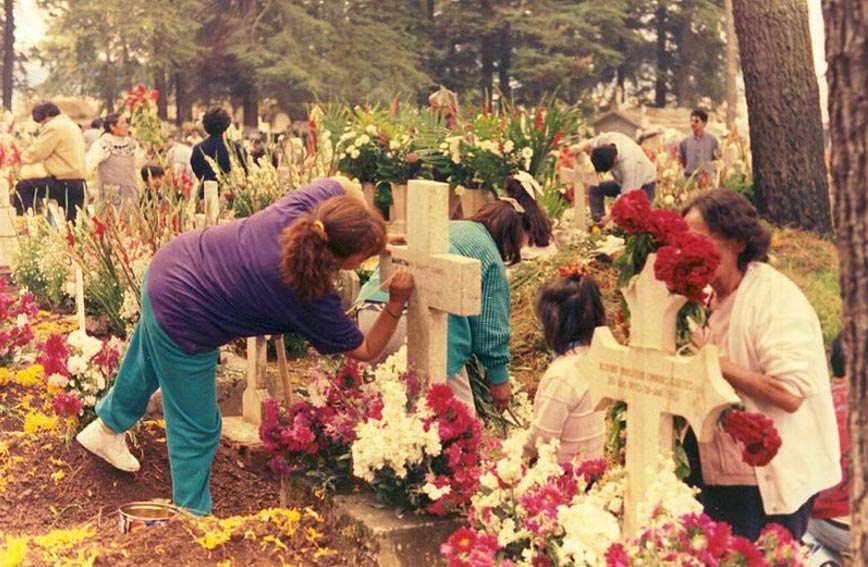
Tidying and decorating graves for Día de los Muertos, Almoloya del Rio, Mexico. (CC BY SA 4.0)
Honoring the deceased is a practice that has taken place in Mesoamerica for thousands of years. The Maya, Aztec, and Toltec all revered their dead ancestors as well, and offered their spirits special gifts during the days (or months) that they believed they returned to earth, to gain their favor.
Both the Andean and Mesoamerican offering ceremonies are seen as very important to the traditional ways of life. They are a means to gather believers and strengthen ties amongst the participants and the community they take place in, as well as the connections between the past and the present. The Andean practitioners also see their ceremonies as a way to ensure the health of both the land and all involved – a means to honor all forms of life and continue the ayni in the relationship between humans and the rest of nature.
Featured Image: A traditional Andean spiritual leader arrives at the location for the offering ceremony with the items needed for the mesa. Source: CC BY NC SA 2.0
References
Beeler, M. (2011). The Despacho Ceremony. http://home.earthlink.net/~megbeeler/earthcaretakers/id39.html
Calle, G. (2012). Las Ofrendas a la Pachamama se Adecuan al Deseo de los Devotos. http://www.la-razon.com/sociedad/ofrendas-Pachamama-adecuan-deseo-devotos_0_1661233903.html
Centro Yachak (2008). Ceremonia Tradicional de Ofrenda a la Madre Tierra. http://www.centroyachak.org/2008/08/ceremonia-tradicional-de-ofrenda-la.html
Gershberg, S. (n.d.). Paying it Forward the Incan Way: Ayni. http://thepathofthesun.typepad.com/blog/2011/09/paying-it-forward-the-incan-way-ayni-.html
Kryon. (2015). Despacho Ceremonia. http://originalkryoneuropa.com/pt/despacho-ceremony/
Quiroz, L. (2014). Ceremonias Chamanismo. http://www.loretoquiroz.cl/chamanismo/ceremonias-chamanismo/
Quispe, A. (2013). Ritual a la Pachamama. http://takiruna.com/2013/12/21/ritual-a-la-pachamama/
Sapan Inka. (n.d.). Ofrendas a la Pacha Mama. http://www.sapaninka.com/es/ofrendas-a-la-pacha-mama/ceremonia-de-ofrenda-a-la-pachamama-despacho
Spiritual Wisdom Americas. (n.d.). Ceremonia de Despacho. http://www.spiritualwisdomamericas.com/sanando-el-alma-ceremonia-de-depacho.php
Stark, A. (n.d). Despacho Ceremonies. http://alexstark.com/despacho-ceremonies/
Sumac Coca. (2008). Ofrenda a la pacha mama. http://www.centroyachak.org/2008/08/ceremonia-tradicional-de-ofrenda-la.html
Zarate, C. (n.d.). Dia de los Muertos: A User’s Guide. http://latino.si.edu/dayofthedead/DODManual.pdf